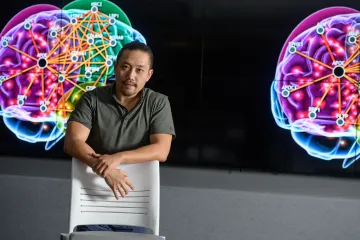
Associate professor Rui Chang is embarking on clinical trials for new ways to
treat Alzheimer’s disease.
Kris Hanning/University of Arizona Health Sciences
University of Arizona researchers have, for the first time, shown that big data and advanced computing could unlock a way to treat and even prevent Alzheimer’s disease. Next step: human trials funded by the National Institutes of Health.
With more than 2,000 samples from a national database of brain tissue from patients who had Alzheimer’s, Rui Chang, associate professor at the College of Medicine – Tucson, created an algorithm that integrates today’s vast but disconnected knowledge of genetics and molecular processes to create a brain model unlike any other.
It allows scientists to see how gene changes at one point in time trigger divergent chain reactions and downstream effects.
The tool revealed 19 genes that, when undergoing changes upstream, lead to downstream amyloid plaques and tau tangles in the brain – hallmark symptoms of Alzheimer’s. Collaborators at Harvard University confirmed that effect in the lab, validating the genes as treatment targets.
Chang then used 3D computer models to rapidly identify 3,000 federally approved drug compounds that “fit” those target genes, not unlike the way keys fit certain locks. Clinical trials will now offer the first tests to discover if any of those compounds could prove the key that not only improves Alzheimer’s symptoms, but actually prevents the disease.
